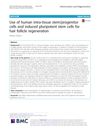TLDR Exosome therapy with laser treatment helped hair regrowth in a child with a rare skin condition.
This case study explores the use of fractional CO2 laser-assisted exosome delivery for hair regrowth in a 6-year-old girl with Morphea en coup de sabre, a condition leading to scarring alopecia. Traditional treatments, including topical steroids and systemic methotrexate, showed minimal success. The novel intervention involved applying rose stem cell-derived exosomes post-laser treatment, resulting in visible hair regrowth by week six and further improvement by week ten. While promising, the study is limited by its single-subject design and lack of inter-observer validation. The findings suggest potential for exosome therapy in treating refractory skin conditions, though larger studies are needed to confirm efficacy and safety.
 July 2024 in “Clinical Cosmetic and Investigational Dermatology”
July 2024 in “Clinical Cosmetic and Investigational Dermatology” Exosomes can help promote hair growth and may treat hair loss.
10 citations
,
February 2022 in “Journal of cosmetic dermatology” Exosomes from fat-derived stem cells may help regrow hair.
18 citations
,
June 2020 in “Dermatologic Therapy” FCO2 laser is a better treatment for alopecia areata than intralesional steroids.
 17 citations
,
February 2019 in “PubMed”
17 citations
,
February 2019 in “PubMed” Stem cells can help regenerate hair follicles.
 November 2023 in “International Journal of Medical Sciences”
November 2023 in “International Journal of Medical Sciences” New regenerative medicine-based therapies for hair loss look promising but need more clinical validation.
 6 citations
,
February 2022 in “Journal of immunology research”
6 citations
,
February 2022 in “Journal of immunology research” Exosomes from fat-derived stem cells can potentially improve hair growth and could be a new treatment for immune-related hair loss.
August 2024 in “Journal of Clinical Medicine” Low-level laser therapy is the most supported treatment for hair loss, but other methods show promise.
 October 2024 in “Dermatologic Surgery”
October 2024 in “Dermatologic Surgery” PRP and PRF show promise for hair growth but need more research for consistent and safe use.
September 2025 in “Pharmaceutics” Combining plant extracts with nanotechnology may improve hair loss treatments.





